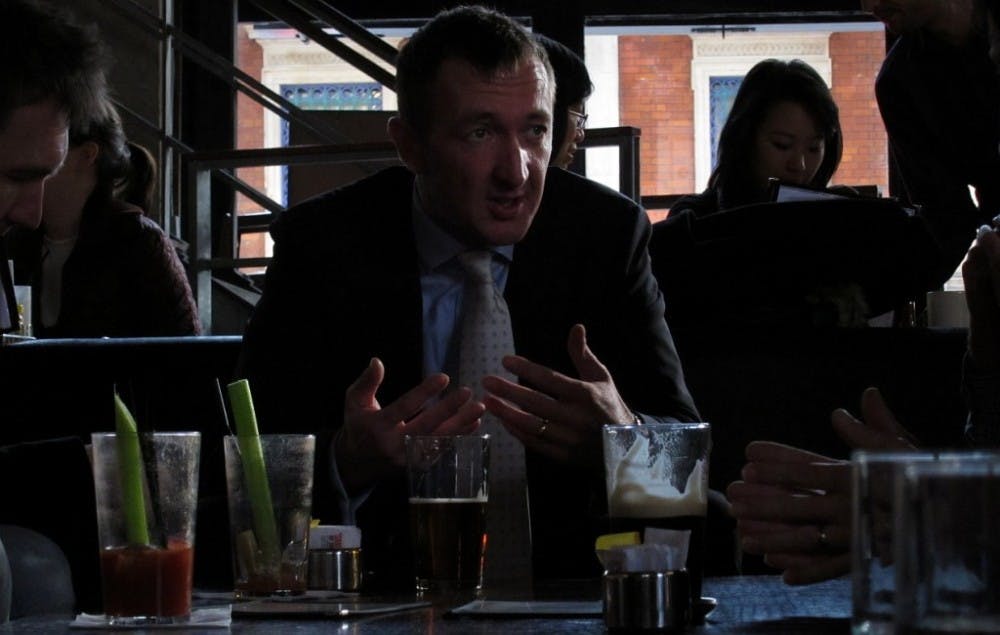Horror in film has certainly had its share of ups and downs over the years, and some may argue that it has lost some of its luster. Whether because of the slasher craze in the ‘70s and ‘80s, the shift to gore in the ‘90s or the avalanche of sequels and remakes over the last decade, this reviewer has found it difficult to get truly excited about any horror film of the last few years. Despite that apprehension, a gem has crept in every now and again, dripping with all manner of scrumptious darkness and depravity. First it was It Follows, then The Babadook. Currently it’s The Witch.
The film tells the story of an Puritan family exiled from a New England colony, headed by patriarch William (Ralph Ineson), as they venture into the wilderness to begin a new life of modest, hardworking Christian piety. Settling near the edge of a grim forest, the family quickly establishes a small farm and even welcomes a newborn child. The land is quiet and peaceful — both things that never last in a story like this.
Unbeknownst to the family, a great evil lurks within those woods, one set not only on destruction but vile corruption. It begins its nasty work very soon, slowly tearing the helpless family asunder and setting into motion a domino effect of suffering the family can only pray to overcome.
The setup of the film is hardly original. While religious horror films of this type have fallen slightly out of style over the years, Eggers does an excellent job recapturing that inherent sense of supernatural dread. From its modest setting to puritan characters, the film’s atmosphere is highly reminiscent of that of similar stories by Nathaniel Hawthorne. (The film particularly seems to draw heavy inspiration from the short story “Young Goodman Brown,” albeit with a much darker twist.) The film’s setting is classically scary, appealing to stereotypes most audiences will recognize: The dark, claustrophobic, misty woods and a ramshackle shack with only dim candlelight to permeate the darkness. Even the film’s symbolic characters and props are extremely familiar and that very familiarity is what gives rise to the film’s greatest strengths.
From familiarity comes investment. With relatively little effort it is a simple matter to connect with the characters on screen, even with personalities, values, settings and lifestyles completely different from those of the viewer. Everything is identifiable, and thus it is all the more tragic when the scene is slowly torn apart.
While audiences know to be afraid and what to be afraid of, just enough is obscured to make nearly every camera shot thoroughly unsettling. As if its horrific atmosphere weren’t enough, Eggers’ script has enough foresight to shy away from one of the cardinal sins of traditional horror: one-dimensional characters.
Whereas many films of this variety will have stereotypical characters who showcase one or two personality traits for the sake of an ironic scare, Eggers crafts a full cast of real people. Every character is given his or her own world and a distinct manner in which they digest and respond to reality. That world of theirs may be called into question at any point, and every character’s values will find themselves shaken to their deathly bones.
Ralph Ineson’s performance as William is excellently multifaceted in this capacity, capturing the devotion of both a religious man and a father while also highlighting the tragic desperation of his attempts to control his life and family. Kate Dickie’s performance as his wife likewise captures an equal amount of desperation, albeit in perhaps a more tragic and terrifying sense.
While admittedly the performances of the child characters are a bit more hit-or-miss, Anna Taylor-Joy’s performance as eldest daughter Thomasin brings an electrifying brilliance to some of the film’s darkest, most unsettling twists in ways that I absolutely refuse to spoil. With more than their lives and well-beings at stake, the characters find themselves at odds with who they are and the worlds of those around them. The chemistry is tense, perpetually dangling on the edge of a precipice. It is truly the essence of horror.
The Witch is not innovative or inventive. It doesn’t create new, fresh ways to look at horror. Instead it takes every tradition that horror has amassed over the last few decades and polishes them to a brilliant shine. There may not be a scream or jump scare in every scene; In fact, audiences certainly shouldn’t expect to be surprised at any point of its 90-minute runtime. What they should expect is an underlying desire to turn away, stopped only by an indescribable desire to see what comes next. You may not jump but you will certainly feel uneasy because this film plays to the tune of an ever-quickening heartbeat.
Overall rating: 9/10






